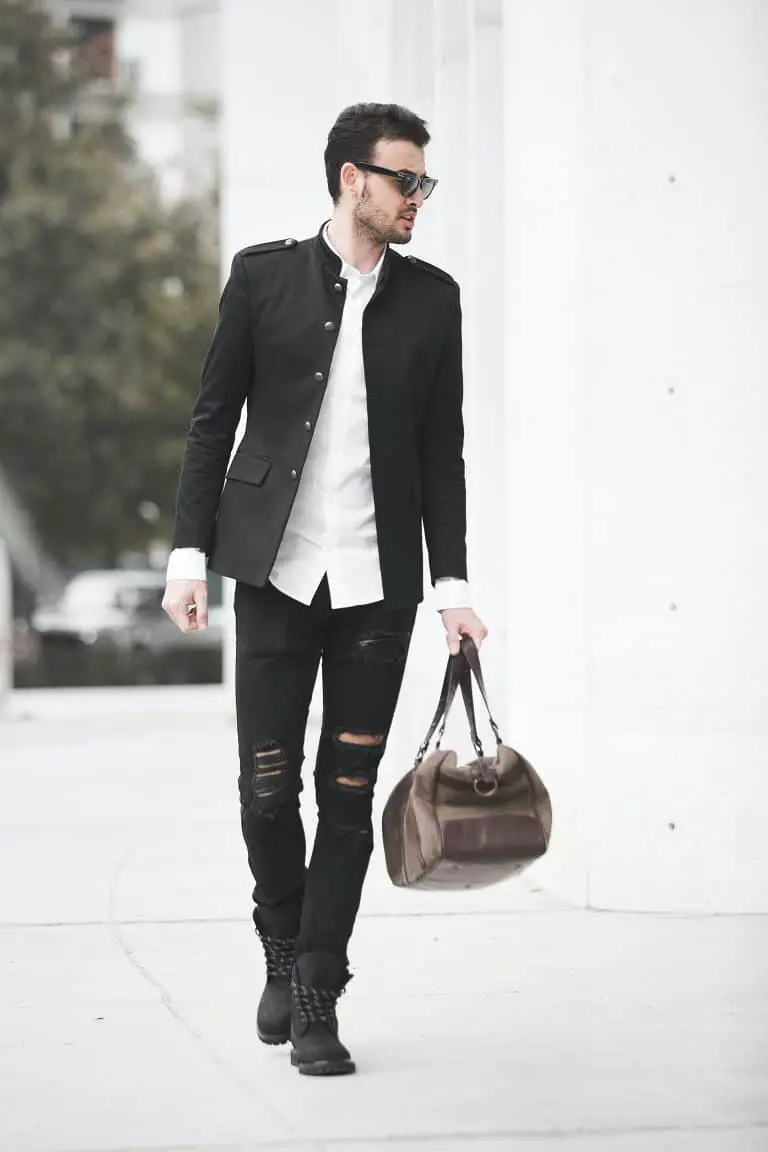Fashion labels Arket and Asket focus on style rather than trends. Minimalist clothing manufacturers based on a permanent assortment are the focus of these companies. For the most part, they don’t carry seasonal lines. Both avoid the latest fads and have similar-sounding names that might easily lead to confusion among consumers. This comprehensive Asket vs Arket comparison explores everything you need to know about these menswear clothing brands, from their history to their products.
Asket vs Arket- Overview
Men’s fashion has developed over the past decade, and there are now more male-centric retailers than ever. The way men dress has gone in the opposite direction. In the big scheme of things, menswear was significantly different in the 1980s and 1990s.
For example, Patrick Bateman’s fashion was all about the accessories: showy clocks, gaudy ties, and even flashier shirts. People were taught that the more they had to display, the higher they were doing in their life.
In their fashion choices, George Clooney, George Michael, Sir Elton John, Jeff Goldblum, and Prince were all doing it, whether deliberately or unconsciously.
However, as seen in the constant Asket vs Arket debates, a shift is taking place right now. Menswear has gotten more polished, discrete, and stripped back in recent years, even if some catwalk designs still have a pre-millennium feel.
Men’s fashion today emulates the likes of Steve McQueen, Alain Delon, and James Dean, all of whom could walk into a coffee shop in London’s Coal Drops Yard and look entirely at home.
Timeless pieces like a well-made white T-shirt or a pair of well-washed chinos that will still look good five years from now are more important than buying new things all the time, which may negatively influence the environment.
Fashion labels Asket and Arket are revolutionizing the fashion industry by abandoning seasonal production and focusing on long-lasting trends that can be worn all year round.
According to co-founder August Bard Bringéus, when having an interview with British GQ, he said, “Asket is the Swedish term for ‘Ascetic,’ someone who lives without material excess or indulgence, a person who focuses on the inner values.” Nothing defines the company better.
ARKET, on the other hand, is a modern-day market that carries essentials for men, women, children, and the home. A primary goal of ARKET is to make high-quality goods more broadly available and affordable to the general public by creating both well-made and long-lasting products.
Asket vs Arket History
When were these top clothing brands founded? And how have they evolved over the few years they’ve been in operation?
Asket vs Arket History- Asket History
Asket was founded in Sweden in 2015. The goal was to replace seasonal collections, which feed fast-consumption tendencies, with a single permanent collection of clothing, distinguished by openness and accountability.
The company’s co-founders, Jakob Dworsky and August Bard Bringéus believed men’s wardrobes should consist primarily of timelessly classic items. The Swedish pair became friends while attending the Stockholm School of Economics, where they had the common goal of creating a product that would have an effect that would last.
Dworsky and Bringéus launched their company in 2015, intending to produce a collection of essential items for menswear. The label, whose headquarters is in Stockholm, Sweden, sells clothing items on Asket.com.
Asket vs Arket History- Arket History
In August 2017, High street giant H&M announced it was launching a new brand called ‘Arket,’ which would focus on style and not trends. ARKET opened its doors on Regent Street, London, and online. After a successful launch in London and online, ARKET has since expanded to Copenhagen, Brussels, and Munich. Stockholm is where the company’s headquarters and design studio are based.
“Arket” means “sheet of paper” in Swedish, which perfectly reflects the brand’s core concepts: archive, archetypes, and market. The archive notion heavily impacts fashion design and research at ARKET, particularly long-term viability. When choosing suppliers, manufacturing techniques, and materials, ARKET highly values environmental stewardship.
Additionally, the ultra-contemporary design of ARKET’s Berlin branch makes it an excellent destination for those looking for a unique shopping experience.
ARKET’s creative director Ulrika Bernhardtz stated they were delighted to open their “second store in Germany at this famous shopping destination.” A beam grid on the façade and abundant natural light make this structure appropriate for our spatial concept and complement our archive system.”
It’s refreshing to find a brand that isn’t influenced by the latest trends, and ARKET is just that.
Asket vs Arket History- Asket Brand Ethos
Asket is a clothing retailer, but their concept of development is a smaller wardrobe and the end of the period of immediate consumption. According to the company’s goal, people should buy fewer and better pieces of clothes, appreciate their journeys, and care for them longer. What it’s known as is the “Pursuit of Minimalism.”
A significant issue is that fashion has become excessively fast-paced, continuously following trends and launching many collections each season. Products made with delicate effort and valuable resources have lost their value at the expense of our society and world. Asket’s mission is to end this, and clothing is the means.
As trends change and wear and tear occur, its products are built to withstand current standards and longevity.
Asket vs Arket History- Arket Brand Ethos
Arket’s mission is to democratize excellence and make the sustainable design more widely available. They hope to inspire good change in the fashion and design business by adopting a circular strategy and high degree of transparency in their operations.
Establishing new things and making claims on common resources entails a responsibility to leave a lasting legacy and avoid damaging actions.
The Arket brand aims to establish a culture of equality and diversity, with a genuine concern for the well-being of others, from the studio, through the supply chain, to the goods and communication.
Asket Marketing Strategy
The Asket vs Arket comparison won’t be complete without reviewing the companies’ marketing strategies. Here’s how Asket markets its products.
Asket Prototype
To put their business plan to the test in Sweden and Germany, Asket began testing a prototype in early 2020. They sent all of its clients an email with a limited trade-in offer. Within seven days of signing up, Asket customers had the opportunity to trade in their garments by mail for a prize. With the help of Asket, the company tested three incentive tiers: low and high rewards that depended only on what customers sent in, as well as a predetermined reward that was independent of the type of garment.
Convenience vs Conversion vs Quality and Quantity
While the high reward group had the highest conversion rates, the fixed reward group had the best quality and quantity of apparel. After observing a decrease in completion rate (sending the garments in after getting the mailing label) due to shipping challenges in Sweden, Asket realized the importance of convenience. Now that Asket has its marketing plan in place, they’re concentrating on making the trade-in procedure as simple as possible for its clients.
Campaign and Stories
A critical moment for Asket came in October and November 2019 when the “Unraveling the Thread Campaign” was launched, demonstrating that Merino wool necessities can be traced from the sheep to the sweater. The ASKET assumed a significant financial and operational risk to purchase two tons of wool from the same Omeo, Australia, farm to make this achievable.
The campaign was launched across multiple media platforms in Europe, including print in the UK, podcasts in the SE, and OOH in the SE. That was to help reach a wider audience. The “Fuck Fast Fashion” wall and activity in Stockholm’s Södermalm were part of the campaign. Because we wanted to get people talking about quick fashion and how much we buy. If you’re interested in learning more, click the icon to the right.
Arket Marketing Strategy
This section highlights the marketing strategy Arket uses to sell its products.
Addressing the Marketing Gap in Quality and Timeless fashion
H&M’s latest brand ARKET aims to democratize quality by offering affordable, well-made, durable products for men, women, children, and the home. The retailer sells the label’s minimalist Scandi-inspired clothes alongside shoes and accessories and homewares from Adidas, Nike, Brio, Converse, and other third-party brands.
ARKET delves into a deep-seated desire for apparel that isn’t fast fashion. According to Mintel’s 2017 Clothing Retailing Report, three-quarters of shoppers value quality over style. More than half (59%) of older Millennials (those between the ages of 25 and 35) believe it is challenging to obtain stylish and durable apparel.
The ARKET brand occupies a distinct and intriguing position in the industry by catering to the fashion-conscious consumer seeking high-quality staples. While the brand is aimed at fashion-conscious millennials, its selection and offer are radically different from what is currently available on the high street. ARKET extends the Cos concept to a broader audience by avoiding the brand’s distinctive boxy designs, making it more wearable and thus more accessible to a broader audience.
Concepts and Campaigns to Give Shoppers Reasons to Buy
The products and concept of ARKET are allowed to speak for themselves thanks to the brand’s minimal store designs. Since half of the womenswear shoppers, according to Mintel research, view clothing shopping as a leisure activity, the outdoor market-inspired stores aim to provide customers with a more enjoyable and relaxed retail experience. On the other hand, in-store installations give a deeper understanding of how clothing is made, further developed online through additional information and stories about the brand’s manufacturing teams and processes.
Make it Easy for Consumers to Find and Re-find Their Favorite Products
An additional ARKET notion is to create an archive by constructing a unique ID numbering system for each object. In addition to the product’s department, category, style, and material, each item is assigned a unique nine-digit code. Thanks to the system’s architecture, customers will quickly and easily locate and re-locate products online and in-store. It’s, therefore, possible to track down a garment’s current edition if you buy it, wear it out, and need to replace or find it later.
Final Thoughts
In the Asket vs Arket brands comparison, these two brands took a stance against trends or fast fashion and their exploitation of human and environmental resources. It’s at the heart of the two brands’ mission to bring back the value of clothing items by creating high-quality, long-lasting essentials. Both Asket and Arket saw the need to move toward a circular business model that would allow them to genuinely maximize the use of their clothing by taking responsibility for them after they’d been sold.







